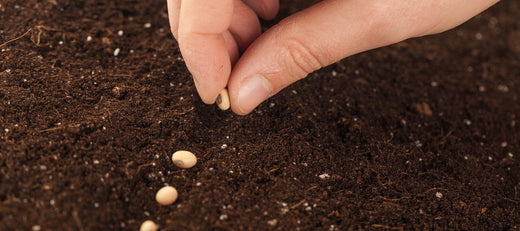July is a busy month for your garden. It is harvest time for many of the vegetables you planted in spring, but it is also the time to start thinking about your fall garden. The key to a successful fall garden is knowing the date of your first frost. We’ve created a Planting Calendar Tool that will let you know your first frost date and provide dates for seed-starting for many varieties.
Here are 15 different vegetables you can start in July for a continued harvest right through the fall.
Start a Second Wave of Quick-Growing Vegetables
July is early enough that many people can get in a second planting of fast-maturing summer vegetables. These include:
- Bush beans - Many bush beans are ready to harvest in 55-65 days and are easy to grow because they do not need a trellis for support.
- Cucumbers - As long as average temperatures are above 65°F, cucumbers can grow well into the fall.
- Peas - Peas can be planted in the spring and again in the fall. They can handle some frost but will die from a hard frost. Choose a quick-maturing variety like Sugar Ann Dwarf Peas
- Zucchini - Zucchini and Summer Squash have a short growing season of 50 to 60 days for another quick harvest. As your spring-planted vines wither, replace them by planting new seeds.
- Tomatoes - In warmer zones like 8-10, you may be able to grow a second round of tomatoes.
Direct Sow Root Vegetables

Start your root vegetables in July so they will develop for harvesting in the fall. Most root vegetables grow best in the cooler fall months.
- Radishes - Radishes are one of the fastest-growing vegetables so it is possible to get multiple harvests between July and your first frost. Cherry Belle radishes are some of the fastest to mature in about 21 days.
- Turnips - Turnips are another fast-growing crop that should be ready to harvest in about 60 days. The turnip roots are delicious, and their greens are tasty and good for you. They thrive in temperatures around 60°F.
- Parsnips - Parsnips have a sweet nutty flavor and should be sown in summer to be ready to harvest after the first frost. Our Half-Long White parsnips are a smaller heirloom variety that can be grown in containers.
- Beets - Beets are an excellent fall crop because they tend to be sweeter and have a more vibrant color if planted in the fall. Sow beets 8 to 12 weeks before your first frost.
- Carrots - Carrots are a classic cool-weather vegetable and will not germinate well in temperatures over 85°F, so you may need to wait until later in July or mid-August to start your carrots. Like beets, carrots tend to be sweeter after a light frost.
Start Seeds Indoors for Planting After the Weather Cools

Fall favorites, brassicas, prefer the cooler temperatures of late August and September but still need 12 to 14 weeks of growing time. You can start these indoors in July and transplant them outside when the weather cools.
- Broccoli - start broccoli seeds indoors 10 to 12 weeks before your first frost and move the seedlings outside about 6 weeks before the first frost. Broccoli thrives in temperatures around 70°F.
- Cauliflower - Cauliflower has one of the longest growing times of all the brassicas. It can take 50 to 100 days for cauliflower to grow from seed to harvest, depending on the variety. You can try our Snowball cauliflower seeds for a quicker maturing variety.
- Brussels Sprouts - Brussels Sprouts need 80 to 90 days to mature and grow best in temperatures between 45°F and 75°F. They will taste even sweeter after going through frost.
- Cabbage - Cabbages are frost-tolerant and like many brassicas, they reach the peak of their flavor after some light frost. Cabbage stores well and is perfect for making sauerkraut for long-term storage.
- Kale - Kale is a cold-weather superfood that takes about 90 days to reach maturity. Kale becomes sweeter with exposure to frost and is an excellent option to bring vitamins and nutrients to your fall diet.
Leafy greens like lettuce, swiss chard, and collard greens also do well in a fall garden. In addition, you can get an additional harvest of parsley and cilantro that do not do well in the heat of summer but thrive in cool fall temperatures.
Before planting your fall garden, it is important to do some clean-up of your spring garden. Remove dead or spent plants and restore the soil with organic compost before planting new seeds.
July is the month to start to reap the benefits of your spring gardening efforts and continue your progress by planning and planting new seeds so you will have fresh, nutritious food well into the fall.
























